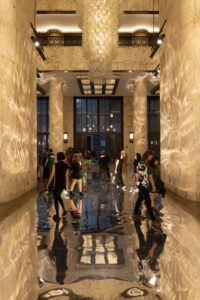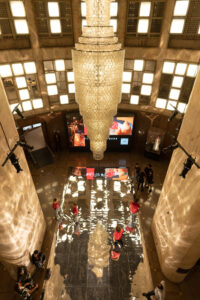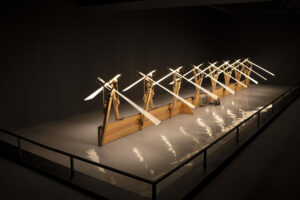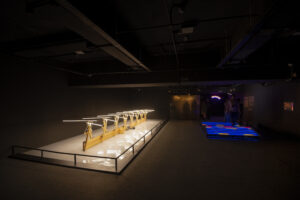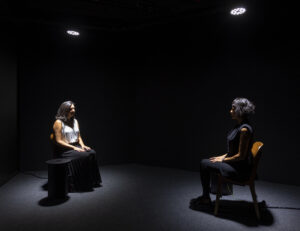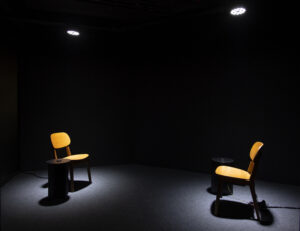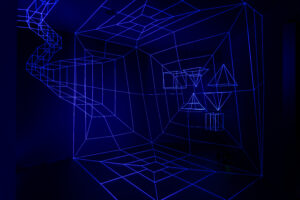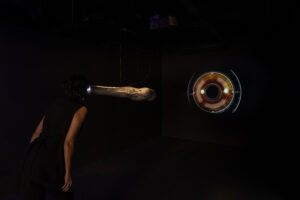SMART LIGHTS – LUZES INTELIGENTES (SÃO PAULO, BRAZIL)
Smart Lights offers an immersion into the fascinating world of light art at Farol Santander São Paulo, from February 1 to May 5, 2024, featuring works and artists that have already circulated through the international art scene and use light as the primary source of their poetic activations. Whether through interactivity, site-specific projects, or immersive experiences, light in this exhibition takes on different expressive dynamics, providing a unique aesthetic and sensory experience.
Conceived by the Instituto URBE and featuring works by Brazilian artists Anaisa Franco, Estúdio Guto Requena, Leandro Lima, Modular Dreams, Motta & Lima, Raquel Kogan, Rejane Cantoni, and Sabrina Barrios, the exhibition is an opportunity to explore the performative possibilities of light through the conceptual depth present in each work.
Smart Lights – Intelligent Lights is presented by the Ministry of Culture through Brazil’s Cultural Incentive Law, with sponsorship from Santander Brasil and partnership with Holy Cow Produções.
OBRAS / ARTISTAS
Piscinão, 2024 - Raquel Kogan e Rejane Cantoni
metalized PETG sheets, foam, connectors, and ellipsoidal reflectors
Interactive site-specific installation in the form of an architectural-scale optical device, conceived to react to the presence and movements of visitors. The work provides an immersive sensory experience that transports participants to a liquid and dreamlike universe. By distorting the perception of space and time, it creates a sensory metaphor for the complexities of urban life, evoking human interaction with the built environment, reminiscent of urban retention basins that orchestrate the water flow.
Raquel Kogan and Rejane Cantoni
Raquel Kogan (São Paulo, SP, 1955) graduated in architecture. She creates video installations, installations, sound artworks, and objects, such as reflexão#1 [reflection#1] (Transmídia Itaú Cultural); reflexão#2 [reflection#2] (ZKM Center for Art and Media and Artists&Robots at the Grand Palais); reflexão#3 [reflection#3] (art@outsiders The European House of Photography Paris); mov_ing (Transitio Festival and Sesc Pompeia). The interactive installation reler [reread], exhibited at the 4th Art.ficial Emotion Technology Art Biennial and at the 20th Curitiba International Biennial, was granted an honorable mention at the File Prix Lux 2010. Kogan shows the interactive installation o.lhar at the Creators Project and Interplay ZKM at the Science Centre Singapore. She develops the interactive work vol.ver for the exhibition Tempo Presente at Espaço Cultural Porto Seguro. Kogan presents the interactive sound artwork falante [speaker] at the 8th 3M Art Show. In 2021, she created #o.lhar, an interactive online artwork for Sesc Pompeia. In the same year, she participated in the inaugural exhibition Da letra à palavra [From the letter to the word], at the Museu Judaico de São Paulo, with the video installation boca fechada [closed mouth].
Rejane Cantoni (São Paulo, Brazil, 1959) is an artist who works with interactive installations and site-specific projects on a large scale. Invited by institutions to create artworks in various cities around the world, she develops innovative installations that offer visceral mediations on how individuals perceive and communicate in the spaces they inhabit. She has exhibited at Ars Electronica (Linz, Austria; Berlin, Germany; Mexico City, Mexico), The Creators Project (New York, USA; São Paulo, Brazil), ZKM | Media Museum (Karlsruhe, Germany), Glow and STRP Festivals (Eindhoven, Netherlands), Moscow Biennale of Contemporary Art (Moscow, Russia), Espacio Fundación Telefónica (Buenos Aires, Argentina), Copenhagen Contemporary Art Festival (Denmark), FILE – International Festival of Electronic Language (São Paulo, Rio de Janeiro, Curitiba, Porto Alegre), Synthetic Times – Media Art China 2008 (Beijing, China), Zeebrastraat (Ghent, Belgium), Mois Multi (Quebec, Canada), Thingworld – International Triennial of New Media Art 2014 (Beijing, China), Ruhrtriennale 2014 (Duisburg, Germany), Asia Culture Center/ACC (Gwangju, South Korea), Wonderspaces (San Diego and Scottsdale, USA), Wavelength (Shenzhen, Shanghai, Beijing [China]), Floras (São Paulo, Rio de Janeiro; Bogotá, Colombia; Lisbon, Portugal; Web3). Rejane holds a post-doctorate in arts, a PhD and master’s degree in communication and semiotics, and a master’s degree in Information Technology Studies from the University of Geneva, Switzerland. Before becoming an independent artist, she was the vice-director and professor at the Faculty of Mathematics, Physics, and Technology at the Pontifical Catholic University of São Paulo (PUC). She is a member of the Interplanetary Initiative at Arizona State University, USA.
Travessia (Esforço coletivo), 2021 - Leandro Lima
wood structure, LED bulbs, microcontroller, and electric servos
Automated luminous sculpture consisting of a long wooden piece formed by a vertebral structure connected to a central keel, composed of sixteen articulated arms that reproduce movements reminiscent of rowing in a vessel. The movement sequences in different patterns, but preserving a constant synchronism; the set adds efforts to create a unit of strength.
Leandro Lima
Since the late 1990s, Leandro Lima (São Paulo, SP, 1976) has used technological devices, the space of the city, and artistic institutions to question the viewer’s experience in the urban environment and everyday activities.
Alongside artist Gisela Motta, Lima has participated in exhibitions such as Yano-a, at the Claudia Andujar Gallery, Instituto Inhotim, Brumadinho, Brazil (2019-); Entreter [Entertain], at Farol Santander, São Paulo, Brazil (2018); Construções e Geometrias [Constructions and Geometries], at the Museu Brasileiro da Escultura e da Ecologia [MuBE], São Paulo, Brazil (2019); Amazônia. The Shaman and Mind of the Forest, at The Nantes History Museum, France (2019); Confusing Public and Private, at the Third Beijing Photo Biennial, China (2018); the Guangzhou Image Triennial, at the Guangdong Museum of Art, China (2017), among others. The duo’s work is present in collections such as the CIFO Art Foundation Collection (Miami, USA), Instituto Figueiredo Ferraz (Ribeirão Preto, Brazil), Itaú Cultural (São Paulo, Brazil), and Pinacoteca de São Paulo (Brazil).
Rainbow, 2011 - Motta&Lima
7 x 3 W-RGB LED, microcontroller, motor, and frequency inverter, variable dimensions
The work is formed by an arch composed of primary-color lights (red, green, and blue) paced in a way capable of forming the seven visible colors of the rainbow. This arc of light does not have a fixed source but is generated by the circular motion of an intermittent emitter. The fast displacement of this source creates, through the persistence of light on the observer’s retina, an arc suspended in space.
Motta&Lima
The partnership between Gisela Motta and Leandro Lima (both born in São Paulo, Brazil, in 1976) began in the late 1990s. Since then, the duo’s work has been presented in exhibitions such as Yano-a (Claudia Andujar Gallery, Inhotim Institute, Brumadinho, MG); Constructions and Geometries (Brazilian Museum of Sculpture, São Paulo); Amazonia. The Shaman and Mind of the Forest (Museum of History, Nantes, France), all in 2019; Entreter (Farol Santander, São Paulo) and Confused Public and Private (Third Beijing Photo Biennial, China), both in 2018; Guangzhou Image Triennial (Guangdong Museum of Art, China), in 2017, among others. Their work is part of collections such as the CIFO Art Foundation Collection (Miami, USA); Figueiredo Ferraz Institute (Ribeirão Preto, SP); Itaú Cultural Institute (São Paulo); and Pinacoteca Collection of São Paulo.
Banco das emoções, 2019-2023 - Estúdio Guto Requena
wooden chairs, heart-rate sensors, microcomputers, bass shakers, and LED spotlights
Interactive furniture where participants can sit and feel each other’s heartbeat in real time. With specially positioned sensors, the heart rate is transmitted through luminous effects and vibrations applied to the wooden structure of the seat, in synchrony with the lighting.
Estudio Guto Requena
Estudio Guto Requena (São Paulo, SP) reflects on memory, culture, and narrative poetics in different design scales, such as objects, spaces, and cities. The studio is divided into four project nuclei: Architecture Nucleus, where they create interiors, scenographies, and buildings; Product Nucleus, where they design objects and furniture; Communication and Media Nucleus, developing programs for TV and the web, consultations, books, lectures, and events; and finally, the Juntxs Nucleus – Laboratory for Empathy, Design, and Technology Studies, where they conceive immersive installations and interactive experiences. What connects all the projects of Estudio Guto Requena is their desire to investigate design and digital technologies in an emotional way to stimulate empathy and collectivity. Their great passion lies in hybridizing the analog with the virtual.
Dreamdeck, 2019 - Modular Dreams
metal structure, acrylic, PS, EVA, addressable LED, weight sensors, and Arduino
Interactive electronic toy for all ages that also doubles as furniture. The movement and weight of your own body as you climb onto the interactive relief installed on the floor trigger the shimmering video images that illuminate the LED mesh beneath the artwork.
Modular Dreams
Created by artists Danilo Barros and Priscilla Cesarino (both born in São Paulo, Brazil, in 1980 and 1979, respectively), the Modular Dreams studio explores art in an expanded and immersive way. Its main elements of language are movement and light, always tied together by conceptual and aesthetic coherence. Its vision and intent are increasingly focused on blurring the boundaries between art and life through their actions and creations. With this mission, and grounded in visual art, their works take on various forms such as music videos, mapped projections, interactive LED art scenography, audiovisual performances, site-specific installations, and printed art in various sizes and formats. Modular Dreams is among the most relevant and active artists in São Paulo’s electronic cultural scene, helping shape and conceptualize it since its early revolutions in the capital. They are particularly known for their residency at the Capslock party, numerous interventions at ODD, and significant participation in the Dutch festival DGTL (where they were responsible for an entire stage and performed for over 10,000 people, receiving an excellent response from the audience and festival organizers). The studio also stands out for having undertaken numerous projects for important brands such as Natura, Rock in Rio, Netflix, Santander, Itaú Cultural, Museu da Imigração, Pixel Show, Red Bull, TNT, Casa de Criadores, T-Jamas, Santista Têxtil, O2 Produções, Agência Bullet, and many others.
Reversa / Reverse, 2024 - Sabrina Barrios
white strings, nylon threads, UV light
Ephemeral and site-specific installation that utilizes light and geometric symbols to create an inverted pyramid symbolizing the feminine. Suspended in space, the artwork immerses the audience in a technological environment while simultaneously simulating ancestral connections through codes and glyphs. By simplifying shapes, colors, and sacred geometry, the installation proposes a return to the essence, conveying the concept of “techno-ancestry.”
Sabrina Barrios
Sabrina Barrios (Santa Maria, Brazil, 1981) worked as a designer in São Paulo, London, and Berlin before moving to New York in 2009 to complete her master’s degree at the Pratt Institute (New York, USA, 2012). Her recent exhibitions include immersive experiences worldwide, such as HoloDeity (Illumination, New York, USA, 2023); Estação Portal (MACS – Museum of Contemporary Art of Sorocaba, São Paulo, Brazil, 2022); Rise of the Missing Planet (NOoSphere Arts, New York, USA, 2022); Frequência do Invisível (MASM – Museum of Art of Santa Maria, Rio Grande do Sul, Brazil, 2019); Feixe (Casa Amarela, São Paulo, Brazil, 2018); Epic of Creation (Arteles, Haukijärvi, Finland, 2017); The Earth Experiment (No4 Studio) and Ley Lines (Wassaic Project), both in New York, USA, 2017; Coup d’Etat (Staten Island Cultural Center, New York, USA) and The Horse Rider and The Eagle (Bains Connective, Brussels, Belgium), both in 2016; Atlantis (Aabenraa Biennial for Contemporary Art, Denmark) in 2015; Orion and Vega (Dumbo Arts Festival, New York, USA, 2014); Degrees of Freedom (Harlem Art Factory Fest, New York, USA, 2013). Sabrina exhibited her paintings at the JustMAD Art Fair (Madrid, Spain, 2016) and Anita Schwartz Gallery (Rio de Janeiro, Brazil, 2014 and 2015); her videos at Bienal desde Aquí (Barranquilla, Colombia, 2015) and MoMA: Abstract Currents (Museum of Modern Art, New York, USA, 2013). Her residencies/grants include The Studios at MASS MoCA (Massachusetts, USA, 2017); Arteles (Haukijärvi, Finland, 2017); The Bronx Museum-AIM Program (New York, USA, 2016); Just Residence-Fundação Banco Santander (Málaga-Madrid, Spain, 2016); Bains Connective (Brussels, Belgium, 2016); and The Wassaic Project (New York, USA, 2015). Sabrina’s work was included in the Fourth Bronx Museum Biennial in New York (2017) and the Baku Biennial in Azerbaijan (2019). She currently lives between New York and Rio de Janeiro, creating participatory and multimedia art.
Expanded Iris, 2022 - Anaisa Franco Studio
customized software, computer, iriscope camera, 3-D-printed telescope, speakers, and a projector
Interactive installation that scans the user’s iris and merges it with galaxies and nebulae through custom software and a 3-D-printed telescope formed by elongating the artist’s iris scan.
Anaisa Franco
Anaisa Franco (Uberlândia, MG, Brazil, 1981) creates affective sculptural works to activate the body and public space through a playful and interactive approach. The artist uses parametric design and digital fabrication integrated with technology to connect physical structural elements with digital expressions using lights, sensors, and new materials. Her pieces reflect the round and curved forms found at molecular and macro levels, connecting and reshaping the way we see the world. Franco holds a master’s degree in advanced architecture from IAAC, Barcelona, Spain, a year of M-Arch 1 at SCI-Arc, Los Angeles, USA, as well as a master’s degree in digital art and technology from the University of Plymouth, England, and a bachelor’s degree in visual arts from FAAP, São Paulo. Her artworks have been presented in various countries such as the United States, Ireland, Australia, France, Germany, Spain, the Netherlands, Switzerland, China, South Korea, and Brazil.
